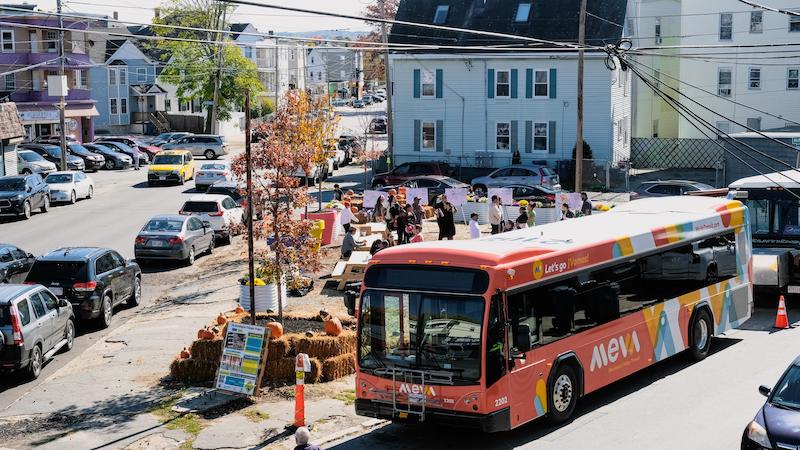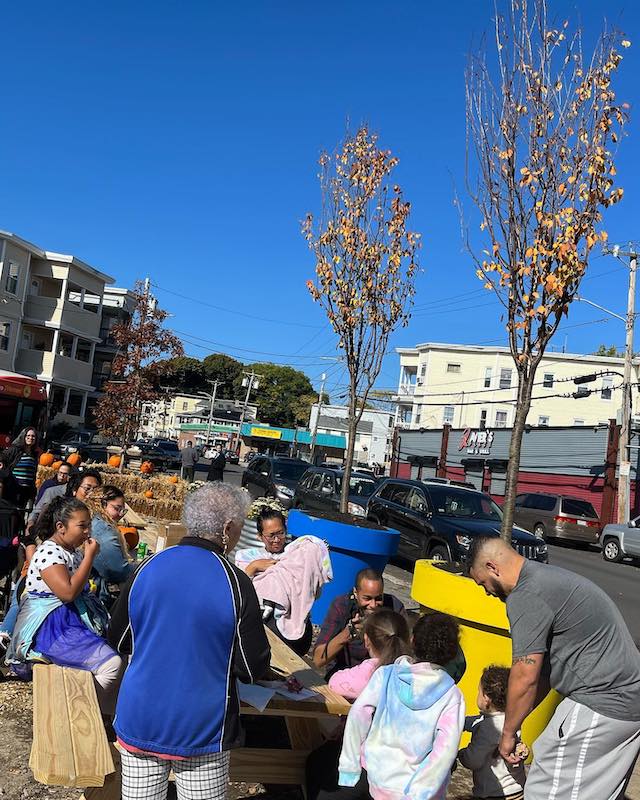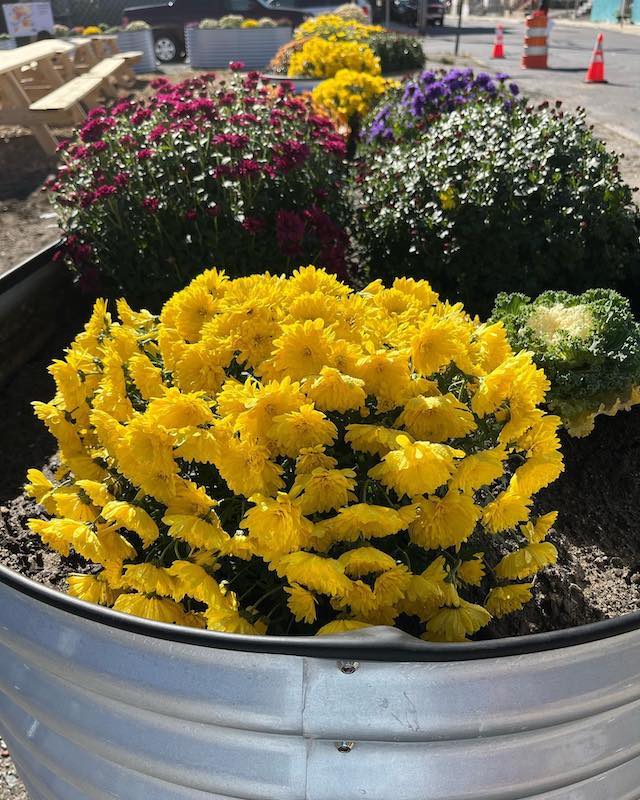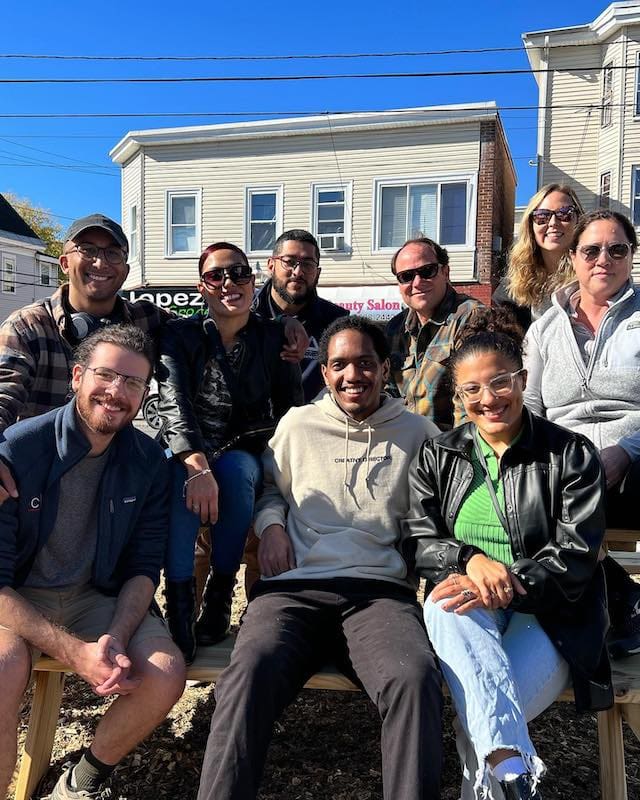On a small triangle of land between Bennington and Lawrence Streets stand picnic tables, corrugated metal beds bursting with flowers, and trees in planters of hot pink, lemon yellow, and royal blue. It’s an uplifting treat in this Lawrence, Massachusetts, neighborhood and a considerable contrast to what stood here before – a jumble of parked cars on a vacant lot. In what is known as Bennington Triangle, residents today gather to shoot the breeze, play dominos, and otherwise enjoy life in the open air.
The color and greenery are part of a pop-up park initiative of Lawrence Pa’Lante, a project designed to improve Lawrence residents’ health and quality of life by addressing critical urban planning and infrastructure issues. One big issue: how to deal with the heat extremes of climate change that have certain pockets of Lawrence baking like a brick pizza oven. Initiated by Groundwork Lawrence and Conservation Law Foundation in partnership with the City of Lawrence, Bennington Triangle, as it is known, is not so much a finished product as a model of what could be. It shows the potential to turn urban heat islands into oases of transformative green space. It also shows how city residents, particularly those in environmental justice communities like Lawrence, where 82% of residents are Latino, can decide for themselves how to resolve environmental and climate change issues.
“People are taking pride in the space and are pushing for it to continue,” says Destiny Gonzalez, who served on the resident task force that helped spearhead the park. “In the beginning, it was very tough because nobody wanted that pop-up park to happen. Nobody wanted us to take away the parking.”
Now that residents have the park, they can’t imagine life without it.
“They took a lot of love to the site,” says Eddie Rosa, Community Programs Director at Groundwork Lawrence, who served as a project manager for the Pa’Lante project.
Neighbors, he notes, tend to the triangle as if it were their own backyard, picking up litter and regularly clearing away trash.
“I have done my own personal cleanups, and I do see people using the space,” says Dorian Straker, another task force member. “That does warm my heart because I had my reservations about the space in the beginning.”

A Vision of Change
Bennington Triangle is small, but its significance for reshaping Lawrence could be far greater than its size would suggest. The park emerged unexpectedly from a larger initiative to educate Lawrence residents about climate and health concerns. As part of this mission, the Pa’Lante project and its resident task force members were first focused on cleaning up air pollution by reducing car traffic and building city “resilience corridors.” The corridors were to provide safe spaces for residents to walk or bike – shady, meandering paths that could perform double duty. That is, allowing residents a place to toss a ball while also providing respite from the sun on hot days. In addition, the corridors might encourage residents to abandon cars for bikes and could provide a place for water to flow when the Merrimack, Spicket, or Shawsheen rivers jump their banks following increasingly frequent storms.
Intent on this objective, Pa’Lante task force members began canvassing Lawrence neighborhoods to educate residents about climate change and resilience. Quickly, they discovered that climate resilience was a remote concern for residents preoccupied with more pressing matters like school, work, and childcare. However, one issue got everyone’s attention: how miserably hot it could get in city neighborhoods on a steamy summer day. In this way, the Pa’Lante task force members, themselves all Lawrence residents well-acquainted with heat, shifted their focus to small but meaningful interventions to reduce the effects of summer heat, including new neighborhood green spaces, bike and pedestrian paths, and white roofs. The Bennington Triangle pop-up park was Pa’Lante’s first pilot project and intended to provide an immediate benefit to neighborhood residents by calming traffic, bringing in a few trees, and giving people a place to gather, thus enhancing a sense of community.
And indeed, the Bennington site proved a perfect case study. A gas station stood on the site for many years before it became an abandoned lot. As such, it is exemplary of a major problem in this former manufacturing town of almost 90,000, where brownfields, including vacant and contaminated textile mills and abandoned power stations, are rife. In Lawrence, brownfields exist in tandem with waste facilities, trash incinerators, and natural gas pipelines. It’s all contributed to significant environmental problems, including air and water pollution and soil contamination.
Fortunately, thanks to the community’s work and with support from the Environmental Protection Agency, Lawrence is beginning to work toward addressing these issues, including reclaiming many contaminated spots and turning them into vibrant green spaces. But even with these victories, much work still needs to be done. It is the hope of Groundwork Lawrence and partner CLF, that Pa’Lante, through Bennington Triangle, can lead the way.
“The goal of the pop-up park was to allow residents to see what is possible there,” says Deanna Morgan, vice president of CLF’s Healthy and Resilient Communities program.
Even more, says task force member Gonzalez, Bennington Triangle provided an opportunity to build more awareness about climate change.
“I feel like it’s a testament to show that having conversations changes minds and at least makes people think in different ways,” says Gonzalez. “And a challenge for us was finding ways to communicate that would be effective with people who don’t have climate change at the top of their mind.”
The Way Forward
The next few years will be dedicated to forming a long-term vision for both Pa’Lante and Bennington Triangle, according to Brad Buschur, Project Director at Groundwork Lawrence. The initial direction of Pa’Lante may have shifted thanks to the input of the five Lawrence residents sitting on the resident task force (currently Destiny Gonzalez, Eve Rodriguez, Matt Furnari-O’Mara, Anthony Curtis, and Dorian Straker), but the task force will continue to look for ways to educate Lawrence residents about climate change and resilience. And when it comes to Bennington Triangle, they’ve been talking with other residents about what a permanent park might look like. Should there be a fence or landform barriers? Maybe a fountain? What about paths? Everyone has different ideas, but there is one thing everyone agrees on.
“There needs to be a place to sit and play dominoes,” says Rosa. “That’s a big thing for them.”
The model of a neighborhood park, with trees, greenery, and places for residents to play a game or sip a cup of coffee, is already spreading beyond Bennington to other parts of Lawrence. The Bennington approach will be applied to Lawrence’s Lower Tower Hill neighborhood. This low-income area includes a public housing project that sits across from two waste facilities, as well as several brownfields. It borders the Merrimack River and is prone to flooding. It is another area of the city where residents living in heat islands suffer through stifling summers. But it’s got potential, says Rosa, as it has ample, underused space along the water, which could become a green park with shade trees and natural plantings. When that happens, residents will be a part of the process.
“What makes a lot of these park renovation projects pretty successful in general is that the community’s involved at every single part of the process,” says Gonzalez. “That’s Pa’Lante right there, making sure that the community’s involved in all decision-making processes happening in the city.
With residents at the forefront, Lawrence can become a much cooler city.



